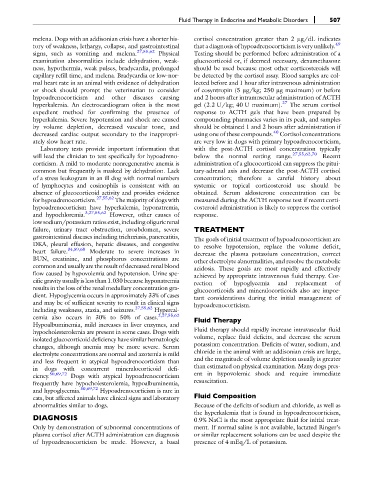Page 519 - Fluid, Electrolyte, and Acid-Base Disorders in Small Animal Practice
P. 519
Fluid Therapy in Endocrine and Metabolic Disorders 507
melena. Dogs with an addisonian crisis have a shorter his- cortisol concentration greater than 2 mg/dL indicates
tory of weakness, lethargy, collapse, and gastrointestinal that a diagnosis of hypoadrenocorticism is very unlikely. 49
signs, such as vomiting and melena. 27,55,62 Physical Testing should be performed before administration of a
examination abnormalities include dehydration, weak- glucocorticoid or, if deemed necessary, dexamethasone
ness, hypothermia, weak pulses, bradycardia, prolonged should be used because most other corticosteroids will
capillary refill time, and melena. Bradycardia or low-nor- be detected by the cortisol assay. Blood samples are col-
mal heart rate in an animal with evidence of dehydration lected before and 1 hour after intravenous administration
or shock should prompt the veterinarian to consider of cosyntropin (5 mg/kg; 250 mg maximum) or before
hypoadrenocorticism and other diseases causing and 2 hours after intramuscular administration of ACTH
hyperkalemia. An electrocardiogram often is the most gel (2.2 U/kg; 40 U maximum). 27 The serum cortisol
expedient method for confirming the presence of response to ACTH gels that have been prepared by
hyperkalemia. Severe hypotension and shock are caused compounding pharmacies varies in its peak, and samples
by volume depletion, decreased vascular tone, and should be obtained 1 and 2 hours after administration if
decreased cardiac output secondary to the inappropri- using one of these compounds. 40 Cortisol concentrations
ately slow heart rate. are very low in dogs with primary hypoadrenocorticism,
Laboratory tests provide important information that with the post-ACTH cortisol concentration typically
will lead the clinician to test specifically for hypoadreno- below the normal resting range. 27,55,62,70 Recent
corticism. A mild to moderate nonregenerative anemia is administration of a glucocorticoid can suppress the pitui-
common but frequently is masked by dehydration. Lack tary-adrenal axis and decrease the post-ACTH cortisol
of a stress leukogram in an ill dog with normal numbers concentration; therefore a careful history about
of lymphocytes and eosinophils is consistent with an systemic or topical corticosteroid use should be
absence of glucocorticoid activity and provides evidence obtained. Serum aldosterone concentration can be
for hypoadrenocorticism. 27,55,62 The majority of dogs with measured during the ACTH response test if recent corti-
hypoadrenocorticism have hyperkalemia, hyponatremia, costeroid administration is likely to suppress the cortisol
and hypochloremia. 3,27,55,62 However, other causes of response.
low sodium/potassium ratios exist, including oliguric renal
failure, urinary tract obstruction, uroabdomen, severe TREATMENT
gastrointestinal diseases including trichuriasis, pancreatitis,
The goals of initial treatment of hypoadrenocorticism are
DKA, pleural effusion, hepatic diseases, and congestive to resolve hypotension, replace the volume deficit,
heart failure. 34,59,68 Moderate to severe increases in
decrease the plasma potassium concentration, correct
BUN, creatinine, and phosphorus concentrations are
other electrolyte abnormalities, and resolve the metabolic
common and usually are the result of decreased renal blood
acidosis. These goals are most rapidly and effectively
flow caused by hypovolemia and hypotension. Urine spe-
achieved by appropriate intravenous fluid therapy. Cor-
cific gravity usually is less than 1.030 because hyponatremia
rection of hypoglycemia and replacement of
results in the loss of the renal medullary concentration gra-
glucocorticoids and mineralocorticoids also are impor-
dient. Hypoglycemia occurs in approximately 33% of cases
tant considerations during the initial management of
and may be of sufficient severity to result in clinical signs hypoadrenocorticism.
including weakness, ataxia, and seizures. 27,55,62 Hypercal-
cemia also occurs in 30% to 50% of cases. 2,27,55,62 Fluid Therapy
Hypoalbuminemia, mild increases in liver enzymes, and
Fluid therapy should rapidly increase intravascular fluid
hypocholesterolemia are present in some cases. Dogs with
volume, replace fluid deficits, and decrease the serum
isolated glucocorticoid deficiency have similar hematologic
potassium concentration. Deficits of water, sodium, and
changes, although anemia may be more severe. Serum
electrolyte concentrations are normal and azotemia is mild chloride in the animal with an addisonian crisis are large,
and less frequent in atypical hypoadrenocorticism than and the magnitude of volume depletion usually is greater
in dogs with concurrent mineralocorticoid defi- than estimated on physical examination. Many dogs pres-
ciency. 50,69,72 Dogs with atypical hypoadrenocorticism ent in hypovolemic shock and require immediate
resuscitation.
frequently have hypocholesterolemia, hypoalbuminemia,
and hypoglycemia. 50,69,72 Hypoadrenocorticism is rare in
cats, but affected animals have clinical signs and laboratory Fluid Composition
abnormalities similar to dogs. Because of the deficits of sodium and chloride, as well as
the hyperkalemia that is found in hypoadrenocorticism,
DIAGNOSIS 0.9% NaCl is the most appropriate fluid for initial treat-
Only by demonstration of subnormal concentrations of ment. If normal saline is not available, lactated Ringer’s
plasma cortisol after ACTH administration can diagnosis or similar replacement solutions can be used despite the
of hypoadrenocorticism be made. However, a basal presence of 4 mEq/L of potassium.

